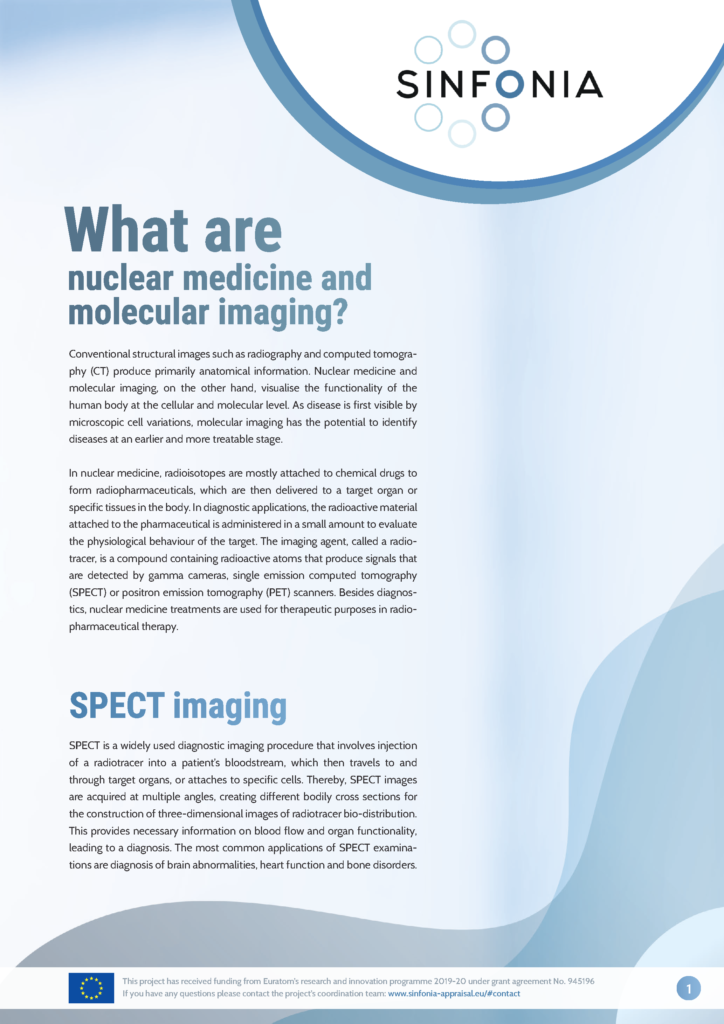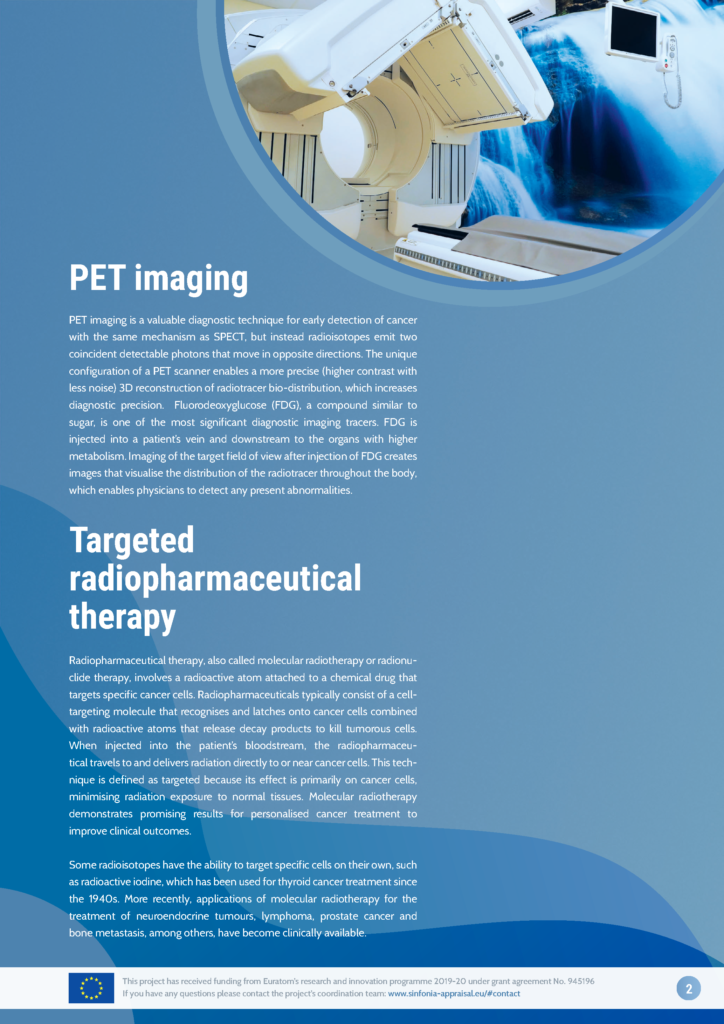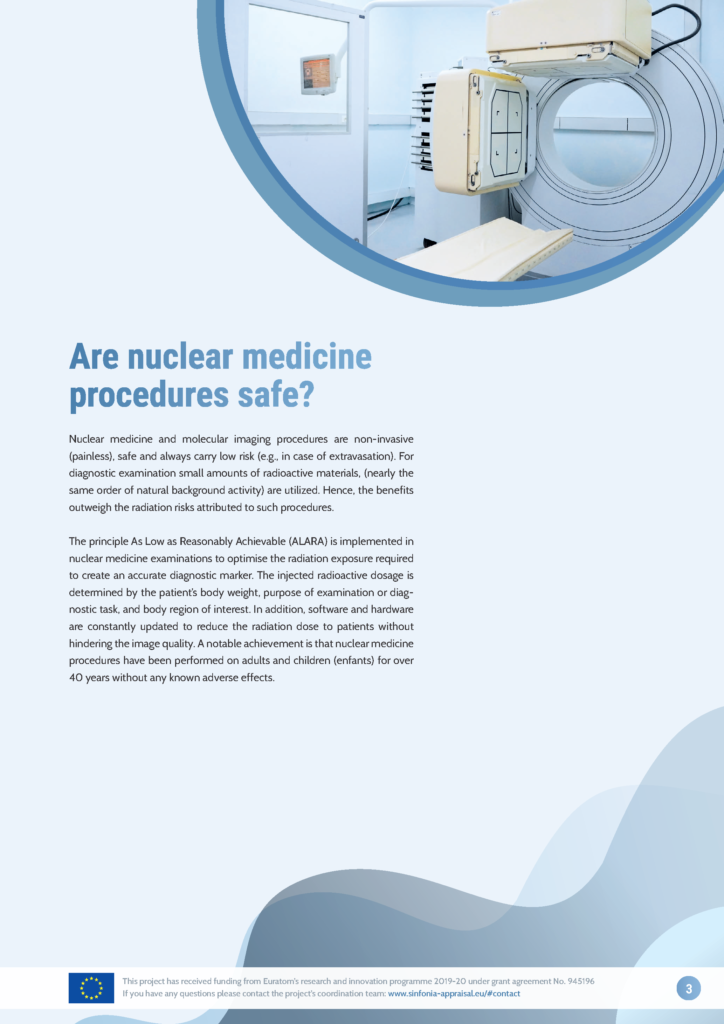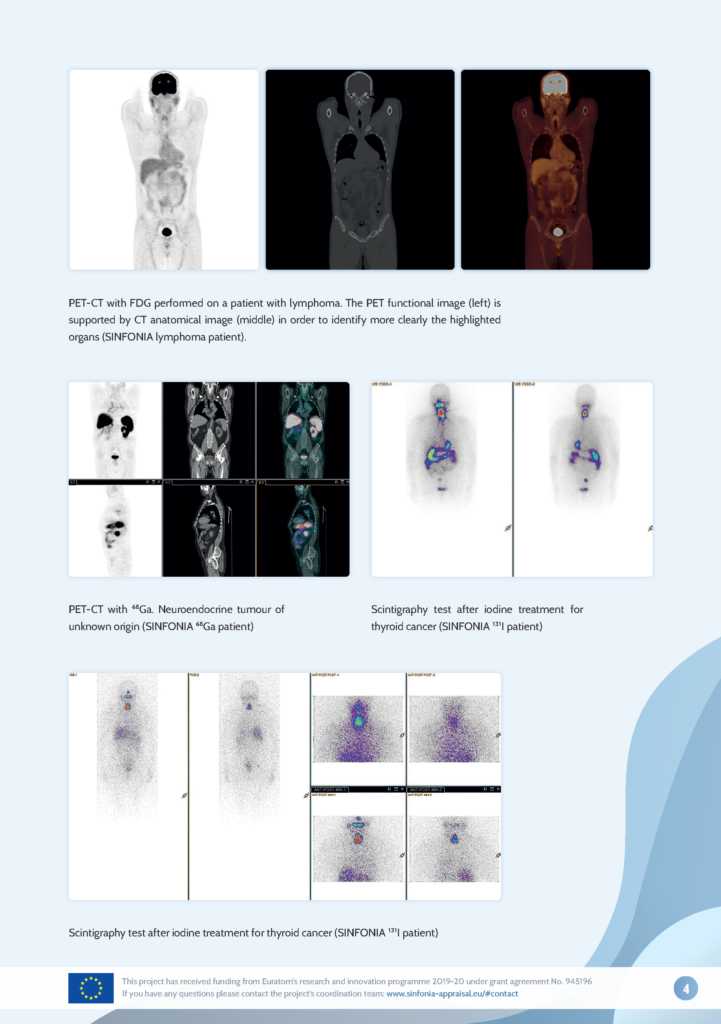



Q&A
How much radiation is involved in nuclear medicine procedures?
Although it depends on the type of procedure, as some treatments require higher doses than diagnostics, and particular attributes such as the patient’s weight, height and gender or the targeted body part, the amount of radiotracers used in nuclear medicine diagnostic examinations is particularly small. Although it is higher in various treatments, the ALARA principle is always used to carefully select the dosage.
How do nuclear medicine proceedings compare with X rays and CT scans?
The average effective dose for most nuclear medicine procedures varies between 0.3 and 20 mSv, whereas standard radiographic examinations range from 0.01–10 mSv and CT examinations between 1–30 mSv. These doses can be compared with an average annual effective dose from background radiation of about 3 mSv.
How long does a nuclear medicine procedure take?
The duration of the proceeding depends also on the type and patient himself. Diagnostic procedures are usually performed on an outpatient basis due to their lower activity. A scan using PET, SPECT or a gamma camera usually lasts between 20 and 60 minutes, but one must also take into account the time required for absorption and subsequent removal of the radiopharmaceutical. Treatment involves longer hospital stays or repeated sessions on an outpatient basis. In some cases, patients remain radioactive for several weeks or even for months.
Are my family and relatives around me safe if I have been treated?
They will stay safe from radiation as long as the instructions provided by physicians are followed. For targeted radiopharmaceutical treatments, as a general rule, you must not sit or stay close to any person either at home or at work. Try to maintain a distance of at least 1 m. For long periods, i.e., more than one hour, stay 2 m away. This is especially important for pregnant women and children, who are more at risk than adults. Particularly, you should avoid contact such as hugging or holding with children under 10, and do not supervise children under 2 years of age be looked. You must keep these rules for several days to weeks, as indicated by your doctor.
For diagnostics procedures, fewer restrictions can be applied.
Should I undergo a nuclear medicine procedure if I am pregnant?
According to the International Commission on Radiation Protection in ICRP Publication 84, Pregnancy and Radiation: “When a nuclear medicine examination is proposed for a pregnant woman, care has to be taken to ascertain that it is indeed indicated for a medical condition that requires prompt therapy. For these diagnostic examinations, the risk to the mother of not performing the examination is greater than the radiation risk to the fetus. The possibility of reducing the administered activity should be considered.” Under no circumstances should you undergo a nuclear medicine examination if there is any suspicion of pregnancy without notifying your physician.
Can I continue breastfeeding?
It is recommended to interrupt breastfeeding for some period after a certain number of procedures. This depends, however, on the examination and isotopes.
Can I interact intimately with my partner if I have been treated?
By and large, any close contact should be reduced after a nuclear medicine treatment. It is recommended, and in some cases mandatory, to sleep in separate beds that should be at least 2 m apart even if separated by a wall. Restrictions are less severe after a diagnostic procedure.
Can I conceive during or after a nuclear medicine proceeding?
The International Commission on Radiation Protection in ICRP Report 84, Pregnancy and Radiation, advises not becoming pregnant for about 6 months after a diagnostic examination and 12 months after treatment. This is partly due to additional medical check-ups for the disease being diagnosed or treated.
Can I go to work as usual?
Although it depends on the procedure, in general most people can return to work. A doctor should be consulted, however, if you are typically within 2 m of a single or group of individuals for more than two hours per day. Additionally, you should always inform your manager.
Can I make use of public transport?
In most cases it is recommended to restrict use of public transport to journeys lasting no more than two hours. Longer trips should only be undertaken if unavoidable. In this case try to find a place where you can sit alone. Ask your physician for advice if the trip is longer.
Glossary
Chemical drug is a chemical substance, typically of known structure, which, when administered to a living organism, produces a biological effect.
Conventional structural images include images generated by diagnostic imaging techniques such as planar radiography, ultrasound, x-ray CT, MRI, etc.
Gamma cameras also called a scintillation cameras or Anger cameras, are devices used to image gamma radiation emitting radiopharmaceuticals.
Metabolism is the chemical reactions in the body’s cells that change food into energy.
Microscopic cell variation or cell-to-cell variation can be understood as genetically, chronologically identical cells expressing the exact same gene at different levels.
Molecular imaging is a growing biomedical research discipline that enables the visualization, characterization, and quantification of biologic processes taking place at the cellular and subcellular levels within intact living subjects.
Nuclear medicine is a recognized medical specialty since the 70s based on the tracer principle.
Physiological behaviour studies focus on many topics relating to the body’s response to a behaviour or activity in an organism.
Radioactive atoms are unstable atoms who expel energy from the nucleus in the form of a particle or ray.
Radioactive iodine includes isotopes of iodine, such as I-123, I-125, or I-131.
Radioisotopes reflects any of the species of the same chemical element that have different masses and unstable nuclei that emit radiation.
Radiopharmaceuticals or medicinal radiocompounds, are a group of pharmaceutical drugs containing radioactive isotopes.
Radiotracer bio-distribution reflects the spatial and temporal distribution of a radiotracer.
Radiotracer is a synthetic derivative of a natural compound in which one or more atoms have been replaced by a radionuclide.
Scintigraphy test also known as a gamma scan, is a diagnostic test in nuclear medicine.
Link to the Glossary of the International Commission for Radiation Protection (ICRP): ICRP Glossary – ICRPaedia